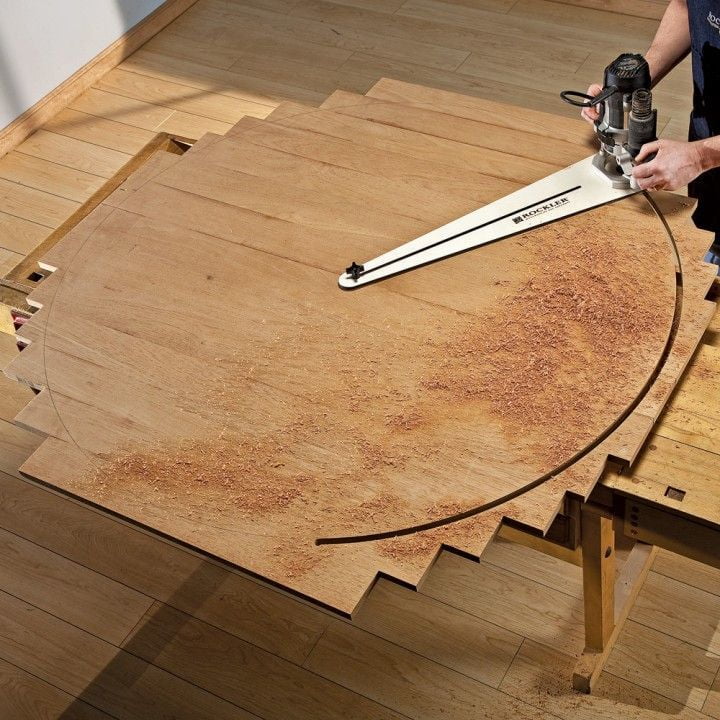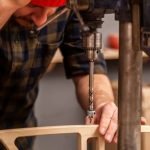Are you a woodworking enthusiast wondering, “What kind of nail gun do I need for woodworking“? Choosing the right nail gun is essential for successful and efficient woodworking projects. With various options available in the market, it’s important to understand the different types of nail guns and their respective pros and cons.
When it comes to woodworking, having the right tools can make all the difference in the quality of your finished product. The type of nail gun you choose can affect not only the efficiency and ease of your work but also the overall durability and aesthetics of your woodworking projects.
In this article, we will explore the importance of choosing the right nail gun for woodworking projects. We will discuss the different types of nail guns available, such as pneumatic and cordless options, as well as brad nailers vs finish nailers. Additionally, we will provide valuable tips for selecting the best nail gun for your specific woodworking needs.
Types of Nail Guns
When it comes to woodworking projects, choosing the right nail gun is essential for achieving professional and durable results. There are several options available for woodworkers, each with its own set of advantages and disadvantages. Understanding the different types of nail guns will help you make an informed decision when selecting the best tool for your specific woodworking needs.
Pneumatic Nail Guns
Pneumatic nail guns, also known as air-powered nail guns, are a popular choice among woodworkers due to their power and efficiency. These tools use compressed air to drive nails into wood, making them suitable for heavy-duty woodworking projects. Pneumatic nail guns are known for their consistent performance and ability to handle large volumes of work without overheating. However, they require an air compressor and hose, which can limit mobility and add extra setup time to your projects.
Cordless Nail Guns
Cordless nail guns have become increasingly popular in recent years due to their portability and convenience. These tools are powered by rechargeable battery packs, eliminating the need for an air compressor or outlet. Cordless nail guns offer greater freedom of movement and can be used in locations where access to electricity is limited. However, they may not provide the same level of power as pneumatic nail guns and require regular recharging.
Electric Nail Guns
In addition to pneumatic and cordless options, electric nail guns are another alternative for woodworking projects. These tools use electricity to drive nails into wood and may appeal to woodworkers who prefer a consistent power source without the hassle of changing or recharging batteries. Electric nail guns are typically lightweight and easy to maneuver, making them suitable for various woodworking tasks.
When considering what kind of nail gun you need for woodworking, it’s important to evaluate the specific requirements of your projects as well as your personal preferences regarding power source, mobility, and maintenance. By understanding the pros and cons of each type of nail gun, you can make an informed decision that will enhance the quality and efficiency of your woodworking endeavors.
Pneumatic Nail Guns
On the other hand, pneumatic nail guns can be bulky and require additional equipment such as an air compressor and hose, which can make them less portable compared to cordless nail guns. Additionally, they may also require regular maintenance to ensure that the air compressor is in good working condition. However, despite these drawbacks, many woodworking professionals still prefer pneumatic nail guns due to their reliability and consistent performance.
When considering what kind of nail gun do i need for woodworking, it’s important to assess the specific requirements of your woodworking projects. For heavy-duty wood fastening tasks that demand precision and power, a pneumatic nail gun may be the best choice. Understanding the pros and cons of using pneumatic nail guns will help you determine if this type of tool is suitable for your woodworking needs.
| Advantages | Disadvantages |
|---|---|
| Precision and power | Bulky and less portable |
| Reliability and consistent performance | Require additional equipment and maintenance |
Cordless Nail Guns
When it comes to woodworking, choosing the right nail gun is essential for ensuring the success of your projects. One popular option that woodworkers often consider is the cordless nail gun. These tools offer a level of convenience and portability that can be appealing, but it’s important to weigh the advantages and disadvantages before making a decision.
Advantages of Cordless Nail Guns
One of the main advantages of cordless nail guns is their portability. Without the need for a hose or compressor, these tools can be used in any location without being restricted by cords or power sources. This makes them ideal for working on outdoor woodworking projects or in situations where access to electricity may be limited.
Cordless nail guns also offer greater maneuverability and ease of use. With no cords to contend with, woodworkers have more freedom to move around and navigate tight spaces without restrictions. Additionally, many models feature quick-release mechanisms for clearing jammed nails, saving time and frustration during a project.
Disadvantages of Cordless Nail Guns
Despite their convenience, cordless nail guns do have some drawbacks compared to pneumatic options. One consideration is battery life – depending on the model and brand, users may need to recharge or replace batteries frequently, which could lead to interruptions in workflow.
Another potential downside is power output. While cordless nail guns are suitable for lighter woodworking tasks, they may not deliver the same level of force as pneumatic models when it comes to heavy-duty applications. Additionally, there is often a trade-off between power and weight with cordless options; heavier-duty models may sacrifice some portability.
Considering these pros and cons can help woodworkers determine whether a cordless nail gun is the right choice for their specific woodworking needs. It’s important to consider factors like project scale and frequency of use when making this decision.
Brad Nailers vs Finish Nailers
When it comes to woodworking, choosing the right nail gun is crucial for achieving professional results. Two popular options for woodworking projects are brad nailers and finish nailers. Understanding the difference between these two types of nail guns can help woodworkers make an informed decision about which tool is best suited for their specific needs.
Brad nailers are designed for precision and delicate trim work. These nail guns use thin 18-gauge nails that leave behind smaller holes, making them ideal for projects where the appearance of the wood surface is a priority. They are perfect for attaching thin moldings and other light trim pieces without the risk of splitting the wood. However, brad nailers may not have enough holding power for larger or heavier pieces of wood.
On the other hand, finish nailers, also known as “trim” or “16-gauge” nailers, use slightly thicker 16-gauge nails that provide more holding strength compared to brad nails. This makes them suitable for attaching larger and heavier pieces of trim or molding, as well as securing delicate pieces that require a bit more support. Finish nailers are versatile and can handle a wide range of woodworking projects, from cabinets to baseboards.
Determining which type of nail gun is best for woodworking ultimately depends on the specific requirements of each project. Factors such as the thickness and weight of the wood being used, as well as the desired finish and appearance, will help woodworkers decide whether a brad nailer or finish nailer is most suitable for their needs. Considering these factors will ensure that the chosen nail gun enhances both efficiency and quality in woodworking projects.
Tips for Choosing the Right Nail Gun for Your Woodworking Projects
When considering what kind of nail gun you need for woodworking projects, there are several factors to take into account. The first thing to consider is the size and type of wood you will be working with.
If you are working with hardwoods, you will need a more powerful nail gun than if you are working with softwoods. Additionally, the size of the nails you plan to use will also determine the type of nail gun that is best suited for your needs.
The next factor to consider is whether you prefer a pneumatic or cordless nail gun. Pneumatic nail guns are powered by compressed air and are typically more powerful than cordless nail guns. However, cordless nail guns offer greater portability and don’t require a compressor, making them more convenient for certain woodworking projects.
Another important consideration is the type of woodworking projects you will be undertaking. For smaller, more delicate projects such as trim work or crafting furniture, a brad nailer may be the best option. However, for larger woodworking projects such as building cabinets or installing flooring, a finish nailer may be more suitable.
Ultimately, when choosing the right nail gun for your woodworking projects, it’s important to carefully consider the specific needs of your project and weigh the pros and cons of each type of nail gun available.
| Factors to Consider | Consideration |
|---|---|
| Wood Type | Determines power needed |
| Nail Size | Determines compatibility |
| Project Type | Determines best tool for job |
Safety Considerations
When it comes to using nail guns for woodworking, safety should be a top priority. Proper training and safety precautions are essential to prevent accidents and injuries. Whether you are a seasoned woodworker or a beginner, it’s important to understand the potential risks associated with using nail guns and how to minimize them.
To ensure safety when using a nail gun for woodworking, here are some important considerations:
- Proper Training: Before using a nail gun, it is crucial to receive proper training on how to operate the tool safely. This includes understanding how to load and unload nails, handle jams, and use the appropriate settings for different types of wood.
- Personal Protective Equipment (PPE): Wearing the right PPE is essential when using a nail gun. This includes safety glasses to protect your eyes from flying debris, ear protection to reduce noise levels, and gloves to protect your hands from sharp nails.
- Work Area Safety: Before starting any woodworking project with a nail gun, it’s important to ensure that the work area is clear of clutter and debris. Make sure there are no tripping hazards or obstacles that could interfere with the safe operation of the tool.
It’s also important to follow the manufacturer’s instructions for the specific nail gun you are using and never modify or bypass safety features. By taking these safety considerations into account, you can minimize the risk of accidents and injuries when using a nail gun for woodworking. Remember that proper training, PPE, and maintaining a safe work area are all crucial elements in ensuring safe usage of nail guns.
Maintenance and Care
In conclusion, choosing the right nail gun for your woodworking projects is crucial to ensure efficiency, precision, and safety. With a variety of options available, including pneumatic and cordless nail guns, as well as brad nailers and finish nailers, it’s important to weigh the pros and cons of each type to determine which best suits your needs. Factors such as ease of use, power source, and nail size compatibility should be considered when making your decision.
Once you have selected the appropriate nail gun for your woodworking projects, it’s essential to prioritize maintenance and care to keep the tool in optimal condition. Regular cleaning and lubrication will help prevent jams and malfunctions, while proper storage in a clean and dry environment can prevent rust and corrosion. Additionally, following safety precautions and receiving proper training on how to use a nail gun are essential steps in ensuring a smooth and accident-free woodworking experience.
Ultimately, choosing the right nail gun for woodworking requires careful consideration of various factors. By understanding the differences between pneumatic and cordless options, as well as brad nailers versus finish nailers, woodworkers can make an informed decision that will contribute to successful project outcomes. And by prioritizing maintenance, care, and safety considerations throughout the tool’s lifespan, woodworkers can ensure that their chosen nail gun remains a valuable asset for many future projects to come.
Frequently Asked Questions
What Type of Nail Gun Is Best for Woodworking?
The best type of nail gun for woodworking is typically a finish nailer. These nail guns are versatile and can handle different types of wood and various woodworking projects. They are perfect for adding trim, molding, and other finishing touches to woodworking projects.
Is a Brad Nailer or Finish Nailer Better for Woodworking?
When it comes to deciding between a brad nailer and a finish nailer for woodworking, it ultimately depends on the specific project at hand. Brad nailers are best for smaller, more delicate wood pieces, while finish nailers are better suited for heavier and more substantial woodworking tasks.
What Is the Best Nail Gun for DIY Projects?
For DIY projects, a good all-around choice for a nail gun is a combination brad/finish nailer. This type of nail gun provides the flexibility to handle both delicate trim work with brad nails and heavier finishing work with finish nails. It’s an ideal option for various DIY projects around the home or workshop.

Hi everyone! I’m a woodworker and blogger, and this is my woodworking blog. In my blog, I share tips and tricks for woodworkers of all skill levels, as well as project ideas that you can try yourself.





